Born in Boston, Massachusetts, Winslow Homer (1836-1910) was always going to become a successful artist. That’s because he inherited the artistic nature of his mother Henrietta.
She was a successful watercolorist and the young Winslow’s first teacher. He never really got a formal art education and mostly learned the trade along the way.
The American artist grew up in Cambridge, Massachusets, a rural town at the time, and initially took up a job as a commercial illustrator in Boston.
This didn’t offer him the challenge that he craved so he decided to open up his studio in 1859 after moving with his family to New York City.
His first major oil paintings were war-related followed by landscapes and maritime subject matter. He included a dense sense of realism that defines his remarkable oeuvre.
In this article, we’re taking a closer look at some of the most famous paintings by Winslow Homer, an important Realism artist of the 19th century.
1. Snap the Whip
- Date created: 1872
- Dimensions: 56 × 91.4 centimeters (22 × 36 inches)
- Location: Butler Institute of American Art, Youngstown, Ohio, United States
Snap the Whip is a painting by Winslow Homer that he completed in the early 1870s. It depicts a group of children in a rural landscape who are playing a game called “Crack the Whip.” This revolves around running around while holding each other’s hands until the “whip” breaks.
The work was painted while Homer was on vacation in New York’s Hudson River Valley. He spent a lot of Summers here because it brought back a sense of nostalgia from his childhood years in Cambridge. The red building in the background is the one-room school building of the little town.
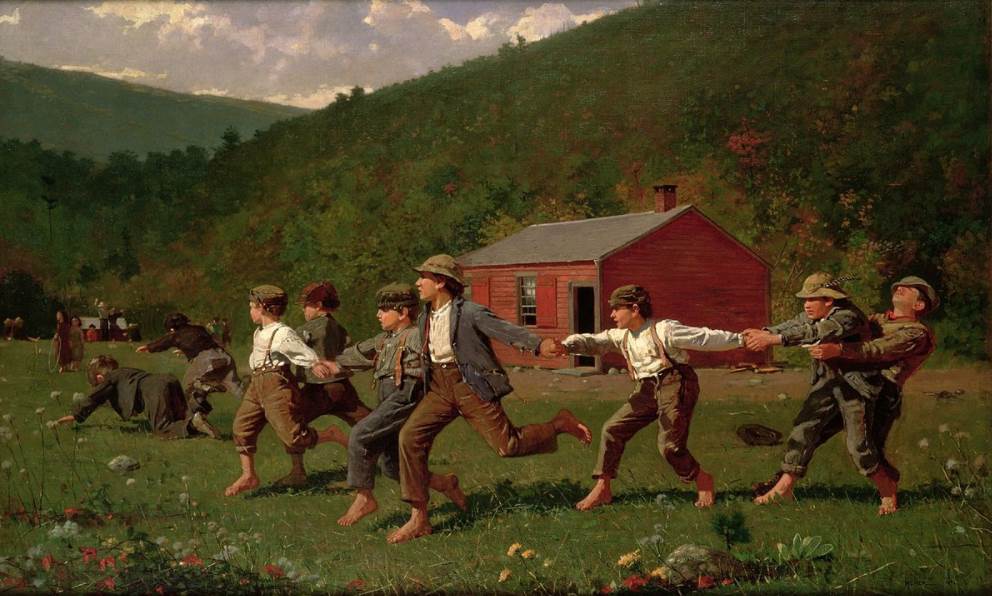
2. The Fog Warning
- Date created: 1885
- Dimensions: 76 × 122 centimeters (30 × 48 inches)
- Location: Museum of Fine Arts, Boston, United States
The Fog Warning is one of many marine paintings that Winslow Homer produced while he was living in Maine in the 1880s. It depicts a local fisherman who is battling the waves of the Atlantic Ocean while two large fish are laying in his small boat.
This type of boat is referred to as a dory and the fish are halibut. The man looks over his shoulder because he sees fog approaching, threatening to cut him off from his ship as he desperately tries to get back. This work is a realistic depiction of the hard life of local fishermen at the time.
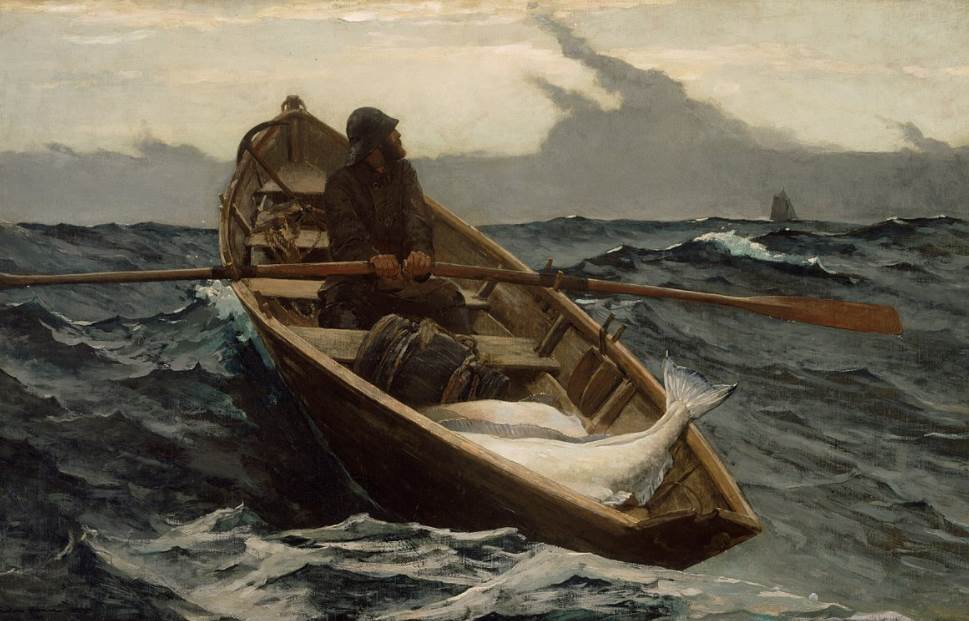
3. Prisoners from the Front
- Date created: 1866
- Dimensions: 61 × 96.5 centimeters (24 × 38 inches)
- Location: MET Museum, New York City, United States
Prisoners from the Front is one of the paintings by Winslow Homer that are related to the American Civil War (1861-1865). he started his career in oil painting by depicting various scenes of life during this important moment in American history.
This particular work depicts Confederate officers who are surrendering to Union General Francis Channing Barlow (1834-1896). It was one of the first major works by the artist and has been described as one of the most notable paintings about this tragic event that was ever made.

4. The Fox Hunt
- Date created: 1893
- Dimensions: 96.5 × 174 centimeters (38 × 68.5 inches)
- Location: Pennsylvania Academy of the Fine Arts, Philadelphia, United States
The Fox Hunt is a large painting of a fox who is hiding in the snow to avoid being attacked by a large number of hungry crows. It’s the largest painting that Homer ever completed which means that he never really produced works that are monumental in size.
The fact that it’s his biggest painting isn’t the only reason why it’s such a special work in his oeuvre. It has been described as “Homer’s greatest Darwinian painting, arguably his greatest painting of any kind.” He produced this work during the harsh winter of 1893 in his studio at Prouts Neck, Maine.
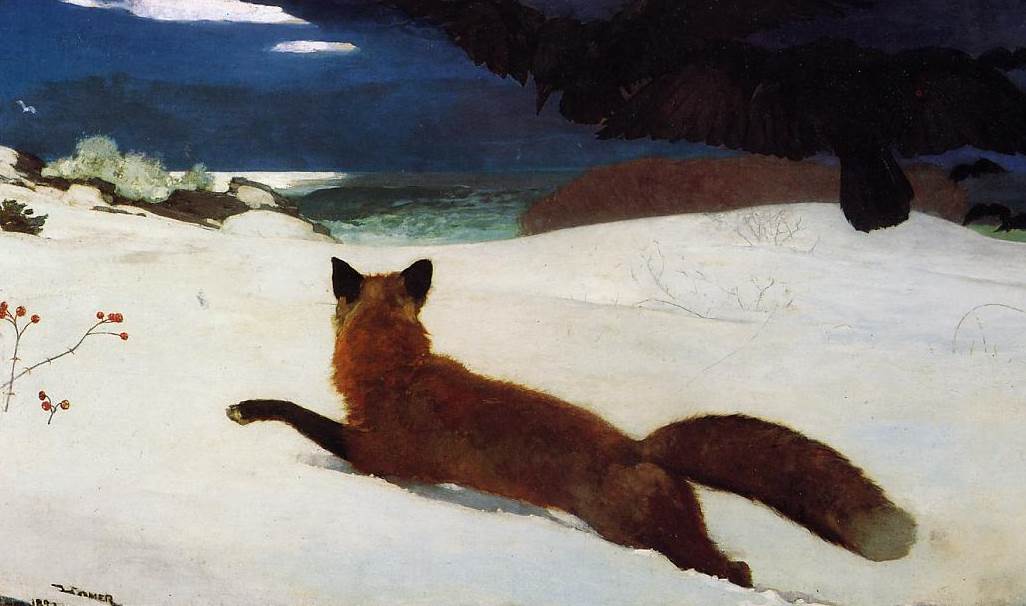
5. Breezing Up (A Fair Wind)
- Date created: 1873-1876
- Dimensions: 61.5 × 97 centimeters (24.2 × 38 inches)
- Location: National Galery of Art, Washington D.C., United States
Breezing Up (A Fair Wind) is the title of another marine painting that depicts a group of people who are sitting in a catboat. That’s a type of boat that features just one mast and a single sail. The name of the boat has been identified as being the “Gloucester,” even though it was just a small boat.
There’s one man and three boys in this catboat who appear to be bringing back their catch. The original title of the work was “A Fair Wind” which means that they had a relatively easy time cruising toward the harbor of Gloucester, Massachusetts.
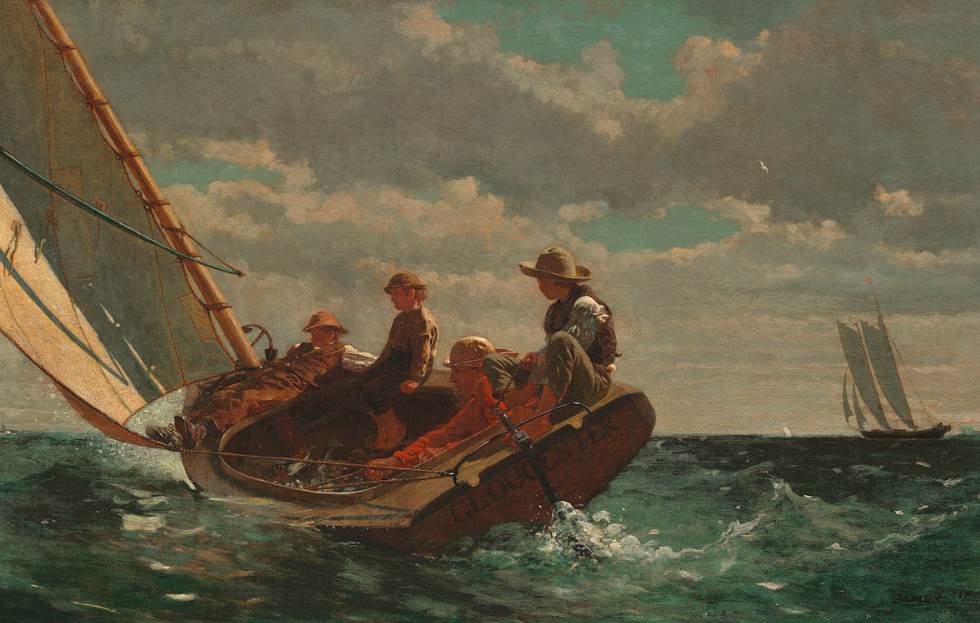
6. The Cotton Pickers
- Date created: 1876
- Dimensions: 61.12 × 96.84 centimeters (24.06 × 38.13 inches)
- Location: Los Angeles County Museum of Art, Los Angeles, United States
The Cotton Pickers is the title of a painting that depicts two African-American women who are picking cotton in a field. Although both women don’t appear to be sad, there’s a sense of melancholia that defines this remarkable work of art by Winslow Homer.
The main reason is the fact that nothing changed for these women, regardless of the American Civil War. They still have the same occupation as before which resembles the life of former slaves. The subject was of great interest to Homer and he aimed to depict the situation as realistically as possible.

7. The Gulf Stream
- Date created: 1899
- Dimensions: 71.4 × 124.8 centimeters (28.1 x 49.1 inches)
- Location: MET Museum, New York City, United States
The Gulf Stream is yet another painting that depicts a man struggling to conquer the mighty waves of the sea. Unlike his marine painting in the northeast of the United States, this work depicts a scene that takes place in the Caribbean. Homer visited Florida and Cuba on several vacations.
The young man tries to get back to shore because he sees the looming danger of a hurricane in the distance. Homer followed up this painting in a work titled “After the Hurricane.” This painting depicts the same man who is washed ashore after the devastating storm had passed.

8. The Veteran in a New Field
- Date created: 1865
- Dimensions: 61.3 × 96.8 centimeters (24.1 × 38.1 inches)
- Location: MET Museum, New York City, United States
The Veteran in a New Field is a painting that was completed shortly after the conclusion of the American Civil War. We can see a farmer who is harvesting wheat in a field, and although this appears to be a rather simple subject, it has a much deeper meaning.
The veteran is cutting down the wheat with a large scythe, a symbolic element referring to the great losses of the war. Wheat is a crop that predominantly grows in the north which might be a reference to the Union’s victory over the South. The attire worn by the veteran indicates that he was a Union soldier.

9. The Herring Net
- Date created: 1885
- Dimensions: 76.5 x 122.9 centimeters (30.1 x 48.3 inches)
- Location: Art Institute of Chicago, Chicago, United States
The Herring Net is a painting that was completed in 1885, two years after he had moved to the small village of Prouts Neck, Maine. It’s one of several masterpieces that he produced here depicting fishermen doing the hard job of catching fish on the rough sea.
This was also shortly after he had visited a fishing community called Cullercoats in North East England. This visit radically changed his career and approach to art. The marine subjects depicted in this work are essentially what made Winslow Homer one of the greatest artists in American history.
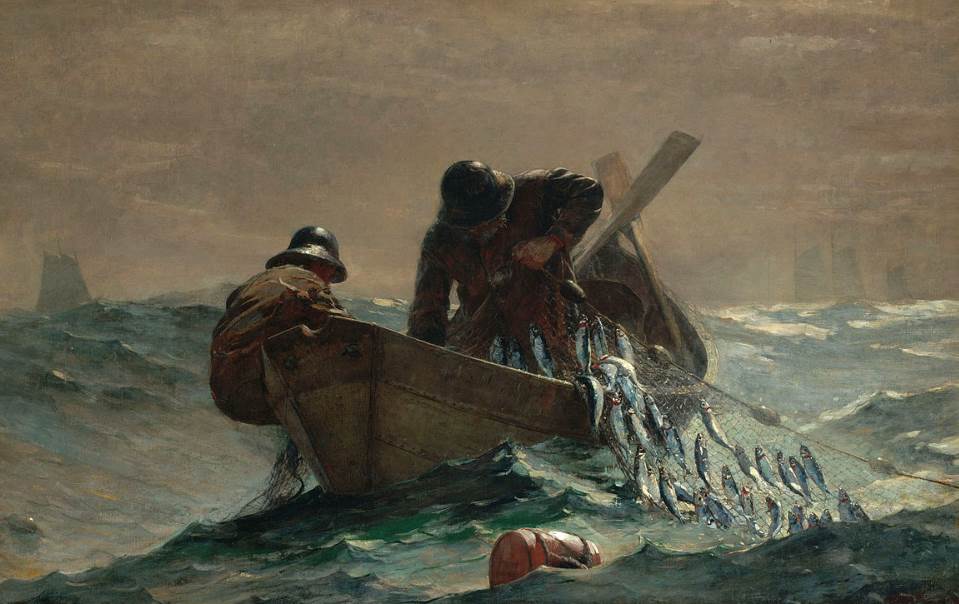
10. Moonlight, Wood Island Light
- Date created: 1894
- Dimensions: 78.1 × 102.2 centimeters (30.7 × 40.2 inches)
- Location: MET Museum, New York City, United States
Moonlight, Wood Island Light is a fascinating painting by Winslow Homer because it depicts the view from his studio in Maine. This nighttime seascape is pretty much the view you have when you look from the balcony of a building that is now referred to as the “Winslow Homer Studio.”
He lived and worked here between 1884 and his death in 1910. It is now part of the Portland Museum of Art and a popular tourist attraction in the region. Equally remarkable about this painting is that Homer appeared to have completed this work in just 5 hours after being intrigued by the view outside his window.



